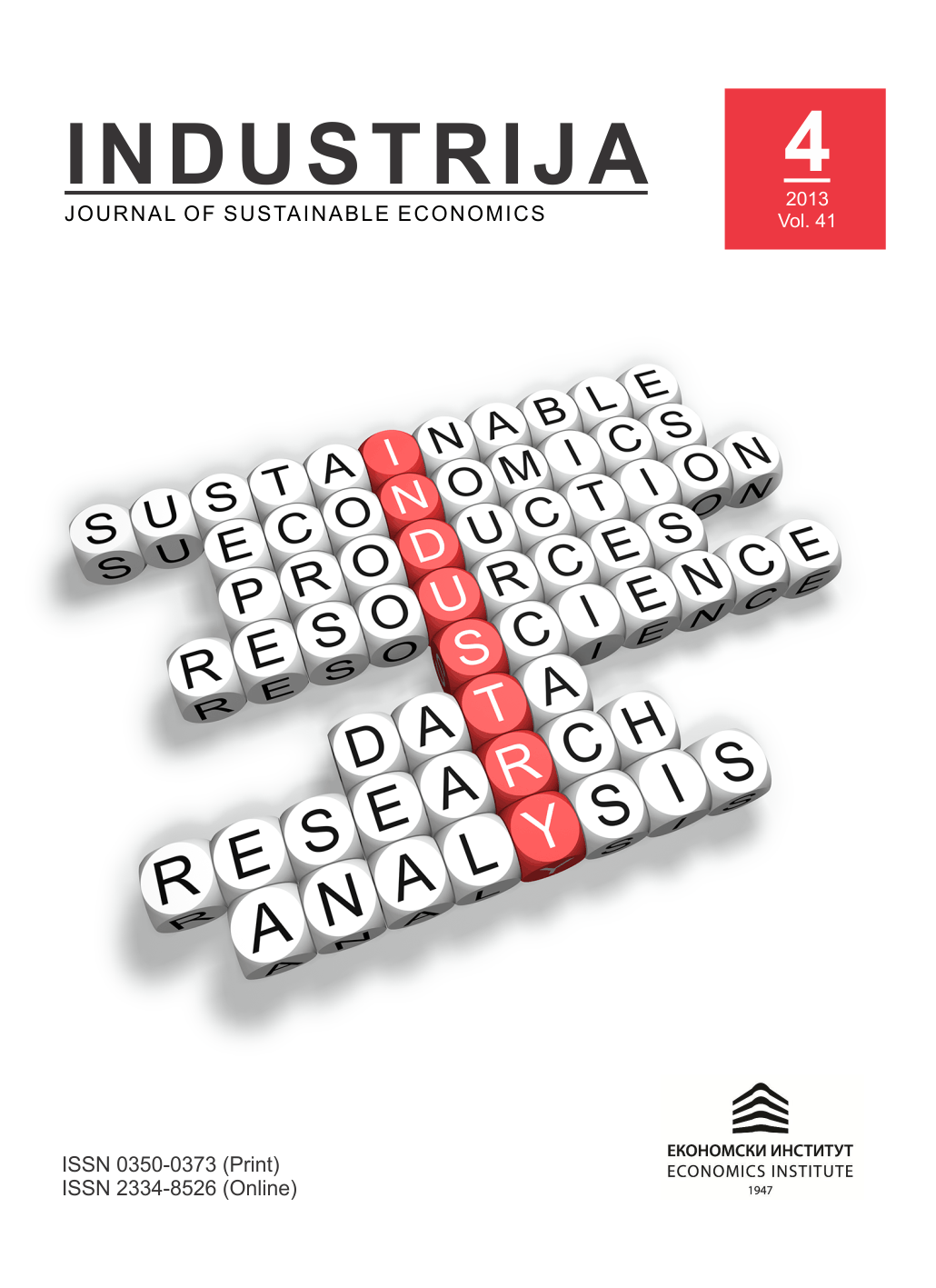Corporate Bankruptcy Prediction in the Republic of Serbia
Sažetak
Reference
Altman , E. (1968). Financial Ratios, Discriminant Analysis and Prediction of Corporate Bankruptcy. Journal of Finance, 23 (4), pp. 589-609.
Altman, E. (2002). Corporate Distress Prediction Models in a Turbulent Economic and Basel II Environment. Accessed on January 13, 2013, at NYU Stern School of Business: http://pages.stern.nyu.edu/~ealtman/Corp-Distress.pdf
Beaver, W., et al. (2005). Have Financial Statements Become Less Informative? Evidence From the Ability of Financial Ratios to Predict Bankruptcy. Review of Accounting Studies, 10 (1), pp. 93-122.
Bharath, S., & Shumway, T. (2008). Forecasting Default with the Merton Distance to Default Model. Review of Financial Studies, 21 (1), pp. 1339-69.
Boritz, E., et al. (2007). Predicting Business Failures in Canada. Accounting Perspectives, 6 (2), pp. 141-165.
Campbell, J., Hilscher, J., & Szilagyi, J. (2008). In Search of Distress Risk. The Journal of Finance, 63 (1), pp. 2899-939.
Charitou, A., Neophytou, E., & Charalambous, C. (2004). Predicting Corporate Failure: Empirical Evidence for the UK. European Accounting Review, 13 (3), pp. 465 – 497.
Dakovic, R., et al. (2010). Bankruptcy Prediction in Norway: A Comparison Study. Applied Economics Letters, 17 (17), pp. 1739-46.
Dechow, P., et al. (2011). Predicting Material Accounting Misstatements. Contemporary Accounting Research, pp. 17-82.
Deventer, D., & Imai, K. (2003). Credit Risk Models and the Basel Accords. Singapore: John Wiley and Sons.
Jayadev, M. (2006). Predictive Power of Financial Risk Factors: An Empirical Analysis of Default Companies. Vikalpa, 31 (3), pp. 45-56.
Lee, W. (2006). Genetic Programming Decision Tree for Bankruptcy. Proceedings of the 2006 Joint Conference on Information Sciences (pg. 2568-2583). Kaohsiung: JCIS.
Mizdrakovic, V. (2012). Komparativna analiza ekonomskih aspekata stečaja (Comparative analysis of the economic aspects of bankruptcy). Accessed on December 28, 2012, at Singipedia – Singidunum University: http://www.singipedia.com/content/3276-Komparativna-analiza-ekonomskih-aspekata-ste%C4%8Daja
Nanda, S., & Pendharkar, P. (2001). Linear Models for Minimizing Misclassification Costs in Bankruptcy Prediction. International Journal of Intelligent Systems in Accounting, Finance and Management, 10 (3), pp. 155-168.
Nguyen, H. G. (2005). Using Neutral Network in Predicting Corporate Failure. Journal of Social Sciences 1 (4), pp. 199-202.
Ohlson, J. (1980). Financial Ratios and the Probabilistic Prediction of Bankruptcy. Journal of Accounting Research, 18 (1), pp. 109-131.
Santos, M., Cortez, P., Pereira, J., & Quintela, H. (2006). Corporate Bankruptcy Prediction Using Data Mining Techniques. WIT Transactions on Information and Communication Technologies, 37 (1), pp. 349-357.
Sen, T., et al. (2004). Improving Prediction of Neural Networks: A Study of Two Financial Prediction Tasks. Journal of Applied Mathematics and Decision Sciences, 8 (4), pp. 219-233.
Shumway. T. (2001). Forecasting Bankruptcy More Accurately: A Simple Hazard Model. Journal of Business, 74 (1), pp. 103-224.
Stanisic, N., Radojevic, T., Mizdrakovic, V., & Stanic, N. (2012). Capital Efficiency Analysis of Serbian Companies. Singidunum Journal of Applied Sciences, 9 (2), pp. 41-49.
Youn, H., & Gu, Z. (2010). Predict US Restaurant Firm Failures: The Artificial Neural Network Model Versus Logistic Regression Model. Tourism and Hospitality Research, 10 (3), pp. 171-187.
Altman , E. (1968). Financial Ratios, Discriminant Analysis and Prediction of Corporate Bankruptcy. Journal of Finance, 23 (4), pp. 589-609.
Altman, E. (2002). Corporate Distress Prediction Models in a Turbulent Economic and Basel II Environment. Accessed on January 13, 2013, at NYU Stern School of Business: http://pages.stern.nyu.edu/~ealtman/Corp-Distress.pdf
Beaver, W., et al. (2005). Have Financial Statements Become Less Informative? Evidence From the Ability of Financial Ratios to Predict Bankruptcy. Review of Accounting Studies, 10 (1), pp. 93-122.
Bharath, S., & Shumway, T. (2008). Forecasting Default with the Merton Distance to Default Model. Review of Financial Studies, 21 (1), pp. 1339-69.
Boritz, E., et al. (2007). Predicting Business Failures in Canada. Accounting Perspectives, 6 (2), pp. 141-165.
Campbell, J., Hilscher, J., & Szilagyi, J. (2008). In Search of Distress Risk. The Journal of Finance, 63 (1), pp. 2899-939.
Charitou, A., Neophytou, E., & Charalambous, C. (2004). Predicting Corporate Failure: Empirical Evidence for the UK. European Accounting Review, 13 (3), pp. 465 – 497.
Dakovic, R., et al. (2010). Bankruptcy Prediction in Norway: A Comparison Study. Applied Economics Letters, 17 (17), pp. 1739-46.
Dechow, P., et al. (2011). Predicting Material Accounting Misstatements. Contemporary Accounting Research, pp. 17-82.
Deventer, D., & Imai, K. (2003). Credit Risk Models and the Basel Accords. Singapore: John Wiley and Sons.
Jayadev, M. (2006). Predictive Power of Financial Risk Factors: An Empirical Analysis of Default Companies. Vikalpa, 31 (3), pp. 45-56.
Lee, W. (2006). Genetic Programming Decision Tree for Bankruptcy. Proceedings of the 2006 Joint Conference on Information Sciences (pg. 2568-2583). Kaohsiung: JCIS.
Mizdrakovic, V. (2012). Komparativna analiza ekonomskih aspekata stečaja (Comparative analysis of the economic aspects of bankruptcy). Accessed on December 28, 2012, at Singipedia – Singidunum University: http://www.singipedia.com/content/3276-Komparativna-analiza-ekonomskih-aspekata-ste%C4%8Daja
Nanda, S., & Pendharkar, P. (2001). Linear Models for Minimizing Misclassification Costs in Bankruptcy Prediction. International Journal of Intelligent Systems in Accounting, Finance and Management, 10 (3), pp. 155-168.
Nguyen, H. G. (2005). Using Neutral Network in Predicting Corporate Failure. Journal of Social Sciences 1 (4), pp. 199-202.
Ohlson, J. (1980). Financial Ratios and the Probabilistic Prediction of Bankruptcy. Journal of Accounting Research, 18 (1), pp. 109-131.
Santos, M., Cortez, P., Pereira, J., & Quintela, H. (2006). Corporate Bankruptcy Prediction Using Data Mining Techniques. WIT Transactions on Information and Communication Technologies, 37 (1), pp. 349-357.
Sen, T., et al. (2004). Improving Prediction of Neural Networks: A Study of Two Financial Prediction Tasks. Journal of Applied Mathematics and Decision Sciences, 8 (4), pp. 219-233.
Shumway. T. (2001). Forecasting Bankruptcy More Accurately: A Simple Hazard Model. Journal of Business, 74 (1), pp. 103-224.
Stanisic, N., Radojevic, T., Mizdrakovic, V., & Stanic, N. (2012). Capital Efficiency Analysis of Serbian Companies. Singidunum Journal of Applied Sciences, 9 (2), pp. 41-49.
Youn, H., & Gu, Z. (2010). Predict US Restaurant Firm Failures: The Artificial Neural Network Model Versus Logistic Regression Model. Tourism and Hospitality Research, 10 (3), pp. 171-187.

